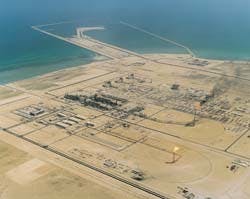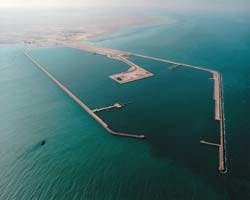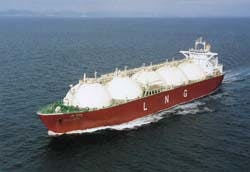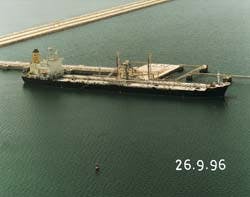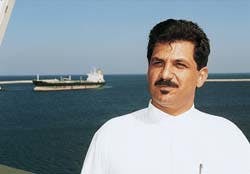Natural Gas in the Middle East Qatargas Exporting LNG From Qatar's New Ras Laffan Port
The Quatargas plant exported its first shipment of LNG to Japan in December.When the 135,000 cu m LNG carrier Al Zubarah departed Ras Laffan Port in December, Qatar entered a new era of commerce that will both boost the emirate's economic development and influence energy trade around the world.
The event capped more than a decade of planning, design, and construction of Ras Laffan Port-the world's newest and largest LNG exporting facility.
During the 1980s, the focus in Qatar was on exploration and development of North field, which holds the world's largest reserves of nonassociated natural gas.
In the 1990s, efforts concentrated on establishing a direct production and export link between North field, the new multi-billion-dollar Qatar Liquefied Gas Co. (Qatargas) gas liquefaction plant at Ras Laffan, and LNG export facilities at the 8.5 sq km Ras Laffan Port.
Markets of the Far East will be first to be served by LNG from Ras Laffan Port. Two 25-year LNG supply contracts have been signed with buyers in Japan and South Korea, and negotiations are under way with potential customers from China, Taiwan, and Thailand.
Talks have also been held with commercial and government representatives in Poland, Croatia, Turkey, and India.
The Emir of Qatar, Sheikh Hamad Bin Khalifa al-Thani, was scheduled to inaugurate Ras Laffan Port, part of 90 sq km Ras Laffan Industrial City, this month.
Ras Laffan Port's exporting capacity can be expanded with addition of two LNG berths along the main breakwater and two liquid cargo berths on opposite sides of the existing berth along the lee breakwater.
The port
Construction of the port, specifically designed for LNG, condensate, and sulfur exports, began in the first quarter of 1992 in what was then a region of empty desert 85 km northeast of Doha.
It was a massive undertaking. Port dredging involved the removal of 10.6 million cu m of spoil, pumped ashore to reclaim port land. Construction made use of about 490,000 cu m of precast concrete, along with 160,000 cu m of concrete cast in situ.
The shipping approach to Ras Laffan Port is a 280 m wide, 5.5 km long entrance channel, dredged to a depth of 15 m below chart datum (CD).
Two huge breakwaters have been constructed. One, to the north, the main breakwater, is 6 km long, while the lee breakwater to the south is around 5 km in length.
Condotte Qatar JV, based in Italy, conducted engineering, procurement, and construction under a multi-million-dollar contract. Dragomar handled dredging, while Grandi Lavori Fincosit of Italy did most of the engineering and design work.
The port at present has two loading berths. They will handle shipments by Qatargas and possibly those of Ras Laffan Liquefied Natural Gas Co. (Rasgas), which is building the second gas liquefaction plant at Ras Laffan and will begin exporting LNG to South Korea in 1999.
There is provision for two more berths to be built at a later stage. One of these probably would be required by a third liquefaction plant, now under study by Enron.
Construction on this plant is expected to begin as soon as sale and purchase agreements have been signed in connection with the venture. Alternatively, the third berth could be used for a second-stage expansion program of Rasgas.
The Al Khor LNG carrier is part of what will be a 10 vessel fleet dedicated to supply of LNG from Qatargas to Chubu Power Co. in Japan.
Port operations
In the first year, two LNG trains will be operational at the Qatargas plant. Volumes loaded at Ras Laffan during 1997 will depend on market demand in Japan. It is likely to build up steadily by yearend to a rate of 4 million tons/year, the design capacity rate of the two trains.
Work on a third train at the Qatargas facility has begun. Its completion in 1998 will take plant capacity to 6 million tons/year of LNG.
By the end of 1997 four LNG ships, including the Al Zubarah and with like capacity, will be operating between Qatar and Japan, with a round trip taking around 29 days. Qatargas is to take delivery of a further six 135,000 cu m vessels between the end of 1997 and 2000, reflecting the expected build-up of consumption by electricity generating companies in Japan.
With the two berths in place, Ras Laffan Port's export capacity is thought to be in the region of 15 million tons/year of LNG.
With all four berths constructed and operational, the capacity could be increased to 30 million tons/year. There then would be plenty of scope for the development of additional production plants within Ras Laffan Industrial City.
Ras Laffan Port also has two dry cargo/container berths, each 300 m long, which can accommodate vessels up to 45,000 dwt. There are also a 150 m long heavy load berth, with a 35 m wide roll-on, roll-off (ro-ro) ramp; a tug berth, 270 m long for as many as four 55 ton tugs, launches, and pilot boats; two berths for the loading of liquid products on vessels up to 300,000 dwt in size, partially laden; and a 420 m area of logistic supply boat berths to support offshore drilling and production operations.
Qatar General Petroleum Corp. (QGPC) made environmental monitoring and control systems part of the design of Ras Laffan Industrial City and will employ full-time environmental scientists at the port to monitor operations and give advice.
Although primarily an LNG-loading facility, Ras Laffan has the potential to handle other cargoes. The container/dry cargo berth already built, for example, can handle bulk cargoes such as urea.
Several international petrochemical companies have approached QGPC to discuss investment in petrochemical plants in the industrial city.
The export of LNG will be crucial to development of Qatar well into the 21st century. Initially, much of the earnings from Ras Laffan will be used to defray borrowing costs; ultimately, however, LNG is set to provide a huge boost to the country's economy.
The condensate ship Koriana loaded the first shipment of gas liquids from Ras Laffan Port in September 1996.
Misnad Al-Misnad, manager of Ras Laffan Industrial City, says the project "symbolizes a new era for Qatar's economy."
Export projects
Central to operations in the immediate future are the two gas export projects, Qatargas and Rasgas.
Qatargas is a joint venture between QGPC, with a 65% share, Total and Mobil, 10% each, and Marubeni and Mitsui, 7.5% each.
It has contracts for sale of a total of 6 million tons/year to Japanese buyers: 4 million tons/year to Chubu Electric Co. and the rest to a consortium of seven other customers. Volumes not taken by those buyers can be sold in the spot market.
Qatargas has responsibility for transporting the LNG to Japan and has commissioned construction of the 10 LNG carriers at yards in Japan.
Qatargas has taken a 25 year time charter on the tankers, which will be managed by Japanese companies: MOL and NYK, four vessels each, and K Line, two vessels.
Work has begun on the Rasgas plant, a joint venture of QGPC (66.5%), Mobil (26.5%), Itochu Corp. (4%), and Nissho Iwai Co. (3%). The facility is due on stream in 1999.
Rasgas has signed a 2.4 million ton/year sale and purchase agreement with Korea Gas Corp. In addition, Chinese Petroleum Corp. of Taiwan, the government of China, the Essar Group of India, and Botas of Turkey have signed letters of intent. Eventually, Rasgas intends to export about 10 million tons/year of LNG.
Shipping arrangements for Rasgas LNG are incomplete. It is believed that Rasgas, like Qatargas, will charter LNG ships, although they may not be newbuildings.
The project proposed by Enron is on the drawing board. Negotiations with prospective buyers, with India a center of attention, are under way. They could lead to construction of another liquefaction facility, with output of 5 million tons/year of LNG, at Ras Laffan.
Copyright 1997 Oil & Gas Journal. All Rights Reserved.
